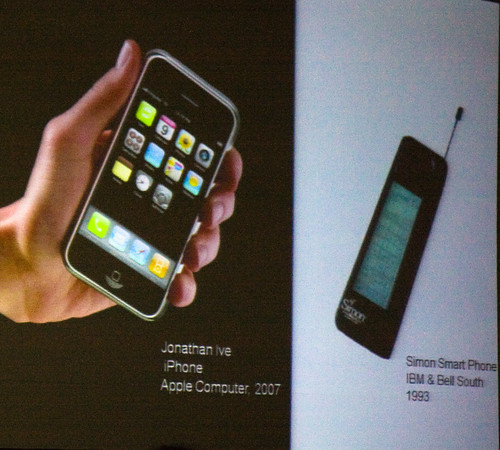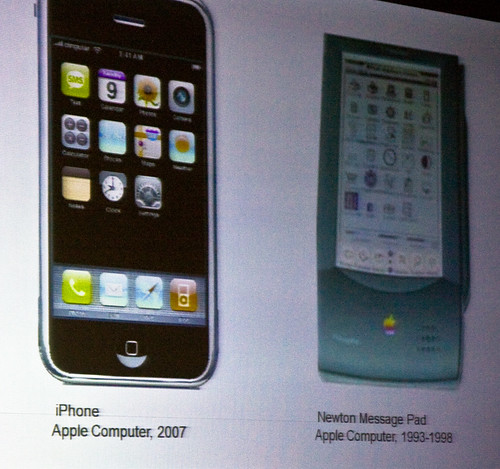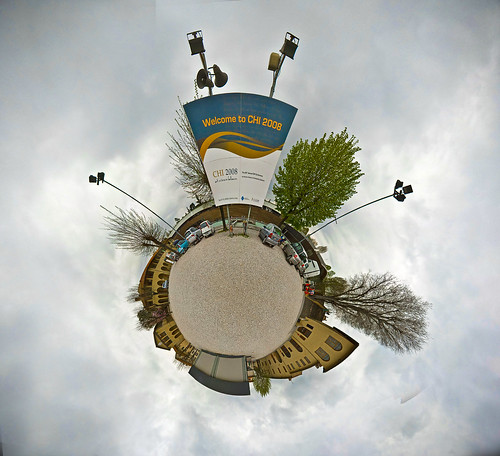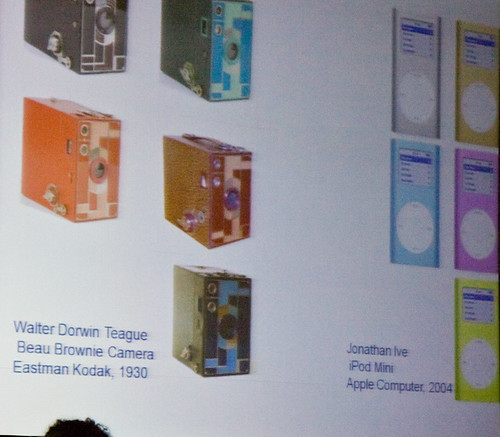Okay, this photo has nothing to do with Bill Buxton’s keynote, except for that it’s a photo planet I made at CHI this year in Florence. The closing plenary talk was the most inspiring talk I heard at CHI. I wasn’t planning on taking notes, but as soon as he said he’d thrown out the talk that he originally planned to give, i got out my laptop and started typing. If I’ve missed any key points, please let me know! Here goes:
Bill Buxton Being Human in a digital age
Technologies are developed with the best of intentions, but they affect the very nature of our humanity.
About Bill and This Talk
I made this talk up this week, so it was a stressful week for me. I knew I had to give something special for my lifetime achievement award acceptance talk, and I wanted to give you guys a talk that you’d never heard before. I chose my parents really well. I grew up in Toronto in a culture of setting the bar very high, which can be learned. You can learn about setting the bar really high, and make a huge difference.
Cellini wasn’t a Sculptor
The Perseus with the head of Medusa, by Cellini in 1545; Cellini wasn’t a sculptor. He worked on it for seven years. He struggled, but he did it anyway. He was a craftsman, not a sculptor. It’s like I always say, you have to have your feet in the mud, but your head in the clouds. “Feet in the mud” is being able to do wood working or soldering or something physical, but “head in the clouds” is a knack for abstract thought.
Kranzberg’s 1st Law
Technology is not good,
Technology is not bad,
But nor is it neutral.
Buxton’s corollary is that technology is not neutral. It’s actually going to be good, or bad, or both. That means that every paper clip we put into an office has an impact on that culture. We need to think about that.
Kranzberg’s 2nd law
Invention is the mother of necessity. When you do put that paper clip in the office you will get some things wrong, but you will hopefully learn what to change
Cultural Change
We’re doing big cultural change by doing industrial or technical design, but we don’t think about what that change is. Why not actually think about it? Like SMS: it’s not a communication platform, it’s helped dating and flirting and American idol in the US.
Twenty year rule
Nothing that transforms our culture is brand new. It always takes twenty years. That means that anything that comes out in the next ten years that is amazing has already been around for ten years. See the long nose of innovation for more info (thx to bill for the link!)
Cultural Memory
Walter Dorwin Teague was a designer around 1926 to 1930. He created the Beau Brownie camera in 1930 that came out in different colors and really tactile materials that were beautiful to touch and look at. Compares it to the Jonathan Ive in 2004 with the iPod Nano’s in different colors. He did not copy it–that’s not what I’m saying. It’s the long nose of innovation, not the long tail. When you have a problem and a design challenge there is a repertoire to draw from.
iPhone

Shows the iPhone next to the Simon Smart Phone by IBM and Bell South in 1993. Our memory is so short. Not to say that these things aren’t brilliant inventions! I say instead of the long tail, it’s the long nose. So the long nose is that if we had a better knowledge of the history, we could give invention a nose job. Ha!
Apple just re-released the Newton?
He wrote a fake press release at Microsoft saying Apple has re-released the Newton:

Marcel Proust Quote
“The only true voyage of discovery is not to go to new places, but to have other eyes.” Basically, you don’t transform things by doing them from scratch, but by seeing them through different eyes.
Some History
The computer hasn’t changed that much. It’s who’s doing what, where, when, why and how. And for how much. There’s not a computer science curriculum in the world that I know of in which you are required to write a program that’s ever used by another human being in order to graduate.
We have to engage the literacy of the people who are using our devices. We don’t want to play “designer as god”.
The Laptop for Every Child Project
You cannot write about art without knowing history deeply. Why is this not more true for technology?
I’m a geek. I love gadgets. I love the PC for every child, but the discourse about this is hard for me to discuss without going through the roof. It was supposed to cost $100 but it really costs $500. Within 100 miles of Boston, third-world communities exist. We could go see if it works there before we send this thing off into the third world. I don’t know, because I haven’t done the research. I’m complaining about the level of discussion about how these things come into our world. We’re the perfect community to have that discussion. Review one less paper, and do some public writing. How can we get engaged?
Books and Music
I can’t design an e-book technology that is as good or better than paper without thinking about how it would affect the world and economy of writing books. People say with music that musicians should just go out and tour and sell t-shirts to make money. But have you ever bought a t-shirt from an author?
Nate says
Doomsday predictions about the economics of new technology are as old as technology itself. IF there’s one thing that recent history has shown, it’s that we can figure out ways to make money using new technology. It might be disruptive at first, and it might not be the same people making money, but someone will make money.
Mozart and Wayne Gretzky
Both of them were in expensive and rigorous education as children. That all cost money! Society said at a certain point that they valued that education, and made it possible. There had to be perceived value.
Simply putting technology in place for people to communicate doesn’t mean people will communicate, or communicate about the things we think will make the world a better place. More on the “What if Leopold (Mozart’s dad) didn’t have a piano” is here ( PDF so ya know ).
Can cultures change?
Absolutely yes. You can do it without wars, and without laws. How did we transform language to be gender neutral? How the hell is there no smoking in bars in Italy? We had a change in values. How did that happen? What can we learn? Believe me, technology was a critical part of it.
Shows a picture of his dogs: “I would have said you were crazy if you told me I would be walking around at night with a plastic bag picking up poo after these two dogs. It’s all about values and culture changing.”
Read Let My People Go Surfing.
He was a blacksmith and rock climber. He went to Yosemite and make pitons and sell them to climbers. He was a dirt bag climber. He innovated the ways that people climb ice and waterfalls. He made black diamond and sold it. Then he started Patagonia. He said “we want your underwear.” They recycle. They do organic cotton. His clothes are cool, too. The company is based on a premise that if the surf’s up or the weather is good you go surfing or climbing. They are paid in passion.
Design
- If you consider the ethics, you can still do great business.
- Get rid of the idea that business, technology, ethics, and design are opposed to each other.
- I’ve done my job and I can say thank you very much for your attention.
Questions
How can you predict the future impact of technology culture?
The only way to engineer the future tomorrow, is to have lived in it yesterday. John Gould and others have taught us that. There are ways to envision the future. Look at the wizard of Oz.
HCI education could learn from Music and Art
You separate the learning of the craft from the learning of the art. You learn the technique first in traditional art before you get to actually practice art. Then later you get to do the creative part where you can break every rule. When you mature, you get to put them together.
You don’t get introduced to math by solving new thermos, you learn to solve the old ones the way that original mathematicians did. You just have to do the technique. You don’t do creativity until you know the technique.
What 10 year old things will have an impact in 10 years?
E-ink. Thin polymer displays. Some things are obscure.
Displays can have RGB and I pixels, so they can pick information up, instead of just RGB.
How can we make enterprise database software as artistic as the iPhone?
It’s easy to make small things. Big systems are hard. You don’t want your heart surgeon or your pension fund manager to innovate on you.
In 1997 you yelled out that you would never come to CHI again because they just didn’t get it. What changed your mind to come back?
Ultimately I can’t figure out a better community to work on these problems. It surprised people that I went to IBM, and that I came back here I guess. I had some time to think. I’m glad I came back. I was younger and wilder then and not so calm and cool and collected.
I also stopped blaming you and CHI for not getting what I need. Instead, it’s my fault. I can say what can I do to get fulfilled.


690 replies on “Bill Buxton’s Bad Ass CHI 2008 Keynote on Being Human in a Digital Age”
A quick comment and, since I know that it is hard to listen, photograph and take notes at the same time, some things to fill in the gaps. :-)
First, the comment. I understand your point that “If there’s one thing that recent history has shown, it’s that we can figure out ways to make money using new technology. It might be disruptive at first, and it might not be the same people making money, but someone will make money.” Likely true. But my concern is not that people will make money with the technology, but that authors will be able to make a living so that they can afford to write. Popular writers will likely always be able to make a living. However, some of the most important writers are far from best sellers. I don’t want to live in, or trust my future, to a world where popularity determines who presents the news (seen FOX or CNN news recently?), or where People Magazine, etc, represent journalism. Serious journalism or fiction take time and money. Both are being seriously eroded already due to modern media, the effects are clear, and we have potentially seen nothing compared to what might be.
I really worry about the “Field of Dreams” approach to such things. That was a movie. I don’t think that we can count on these things being well solved any more than we can count on ball players coming out of the corn-field. What I was arguing was that in designing technology that we can do better than just design it and trust that the problems will be taken care of down the road. I think addressing them, or at least considering them, should be part of the designer’s responsibility.
I suspect that we are not so far apart on this matter. I just wanted to emphasise the intent of the point that I was trying to make in the talk.
Now, on to gap filling:
The quote is from Marcel Proust, and is: “The only true voyage of discovery is not to go to new places, but to have other eyes.”
Regarding the 20 year rule, the essay on the “Long Nose” is at:
http://www.businessweek.com/innovate/content/jan2008/id2008012_297369.htm
The stuff around Mozart that I was talking about can be found at:
http://www.billbuxton.com/leopold.pdf
Thanks for the great notes and taking the time and care to make and share them.
All the best.
Bill Buxton’s CHI 2008 Closing Keynote…
I’m back from CHI and will be posting notes about it over the coming weeks (I am so not a live-blogger). There were a number of sessions that I think will be of interest to readers of this blog, starting…
Marcel Proust, I think. Thanks for taking notes!
nice post, thanks.
would like to ask a question in response to this statement, ‘You separate the learning of the craft from the learning of the art. You learn the technique first in traditional art before you get to actually practice art. Then later you get to do the creative part where you can break every rule.’
Do you think not knowing the rules can also result in rules being broken, because you come at things from a unique angle?
[…] the Bolt/Peters blog, notes on Bill Buxton’s closing talk at CHI 2008. If Buxton were to get smashed in a bar and start rambling about seemingly nothing it […]
In response to det:
Your question is a good one. For sure, knowing the rules of the status quo can impose blinders that keep you from seeing things in a different way.
On the other hand, if you do want to break the rules, the better you know them, the more effective you can be in doing so.
However, I had two concerns/motivations in making the point about separating art from craft.
First, I have seen two many students tossed into the deep end and be asked to do something creative, brilliant even, and – oh by the way – figure out what tools to use and how to use them in a creative way at the same time. From my perspective, more often than not the result is that the poor student does not know where to direct their attention, much less their creativity. Yes, there is a strong link between technique/tools and content. But the broader the palette of tools and techniques that I have, the more solid my ability to choose the rigt one for the idea that I have. That’s not the whole story, but a taste.
The second concern/motivation for the separation is this: by reproducing classic and rich examples from the history of our field, we serve two purposes. We free your mind to focus on execution and technique, which prepares you for later. And, one learns the history in a deep experiential way. This has been a foundation of art and music training for centuries.
So, coming back to your question: yes, you may be able to do something brilliantly new by not knowing either the history or the rules. But I would suggest that you would not have the technique to do so repeatedly, on demand – which is the job of the professional designer. Furthermore, look at the examples of the greatest rule breakers, be they John Cage or Picasso. From my knowledge of art or music history, the great ones all knew what they were doing in the context of the history and tradition of their craft/art.
Finally, I am not being dogmatic. I am just suggesting an alternative to what is currently usually done. And, here is the kicker: in so doing, I am trying to change the status quo precisely by taking advantage of my knowledge of the history, and drawing on it.
Hope this helps. Thanks.
[…] Bill Buxton’s Bad Ass CHI 2008 Keynote | The Bolt | Peters and Ethnio Blog Notes of Buxton’s keynote for CHI 2008. I particularly like the bits on the long nose of innovation and ethics and design and everything really. Read it. (tags: billbuxton chi2008 keynotes presentations notes) […]
Thanks for the info Bill – I added those links/fixes! About authors making a living with new technology – I am absolutely fascinated with this topic, and I totally agree with what you’re saying about the field of dreams approach being wack. Since the existing state of publishing doesn’t necessarily prioritize the money and ideas of an author, especially the non-famous ones, I just think the interwebs offer the possibility of direct revenue and control to authors. I DON’T think that will actually happen since publishers serve a crucial role. But I do think there is a somewhat common conception that the current distribution system matched compensation for authors with true market demand, and provided a way for authors to make a living. It was one way, and has it’s pros and cons. If there is a better system, I totally agree it is taking extraordinary effort to create, and definitely the field of dreams approach won’t cut it. We are trying to work with Creative Commons or anyone that can actually help build a better method for compensation and distribution.
I got a lot of this from a history professor at the University of Chicago, Adrian Johns, who taught an awesome “sociology of technology” course at UCSD, where we read the original patent and copyright conceptions of Milton and Blackstone. Fascinating stuff. The best part is that it wasn’t *that* long ago, in western culture, that if you had an original idea such as a poem or a play, you were considered a funnel for god’s creativity on earth and gave your idea to the king as god’s representative. So it’s not hard for me to imagine a new cultural perception of what an author is and how their ideas get compensated – but it’s gonna be a while. And man I hope we can make a difference in that change.
[…] Being human in a digital age – Bill Buxton […]
[…] CHI (the annual human-computer interaction bash) this year (the speech is summarised by Nate Bolt here). He described innovation as having a long nose: products and services that succeed usually have […]
CHI conference concluded…
Yesterday, the CHI conference came to a close. The closing plenary was held by Bill Buxton who received the CHI Lifetime Achievement Award this year. It is the highest award by the ACM in this field and recognizes outstanding contributions to CHI. In m…
[…] About Bill Buxton’s CHI2008 keynote: “Nothing that transforms our culture is brand new. It always takes twenty years. That means that anything that comes out in the next ten years that is amazing has already been around for ten years“. Well the power of s-curve […]
Hi Nate,
cool, thanks for your effort. I took a different approach to capture Bill’s talk; I took several photos and reconstructed his slides. See:
http://www.slideshare.net/mprove/on-being-human-in-a-digital-world
and
http://www.mprove.de/events/08/chi/buxton.html
-Matthias
[…] was speaking at CHI2008 where he received a lifetime achievement award. (See a wonderful report of Bill’s CHI2008 keynote. By the way, too bad I couldn’t find a video of the keynote […]
[…] Buxton on Innovation and the Long Nose Theory Bolt|Peters summarizes Bill Buxton’s talk at CHI 2008, which is focussed largely around his theory of long nose. The article in BusinessWeek […]
[…] brings to mind Bill Buxtons keynote at CHI 2008, where he basically put out a call for designers to consider the wider implications of their […]
[…] tried to find Bill Buxton’s closing keynote on youtube. Well I couldn’t find it so far, but instead got these two videos from an […]
Reconstruction of Bill Buxton’s closing keynote at CHI 2008 in Florence. … On Being Human in a digital age Matthias Müller-Prove User Experience Architect Sun … Kranzberg’s First Law: Technology is not good, technology is not bad, .
This has been a very significant blog indeed. I’ve acquired a lot of helpful information from your article. Thank you for sharing such relevant topic with us.
I want to say that this post is awesome, great written and come with almost all significant infos. I’d like to peer more posts like this.
Thanks for showing this awesome guide, very interesting.
I recently came across your article and have been reading along. I want
to express my admiration of your writing skill and ability to make
readers read from the beginning to the end.
Technologies are developed with the best of intentions, but they affect the very nature of our humanity.
I totally agree it is taking extraordinary effort to create, and definitely the field of dreams approach won’t cut it.
One
thing I really like about informational articles is that they can influence a
reader’s thoughts. This article is one of those articles. I am highly
impressed with your work and hope to read more.
You learn the technique first in traditional art before you get to
actually practice art. Then later you get to do the creative part where
you can break every rule.